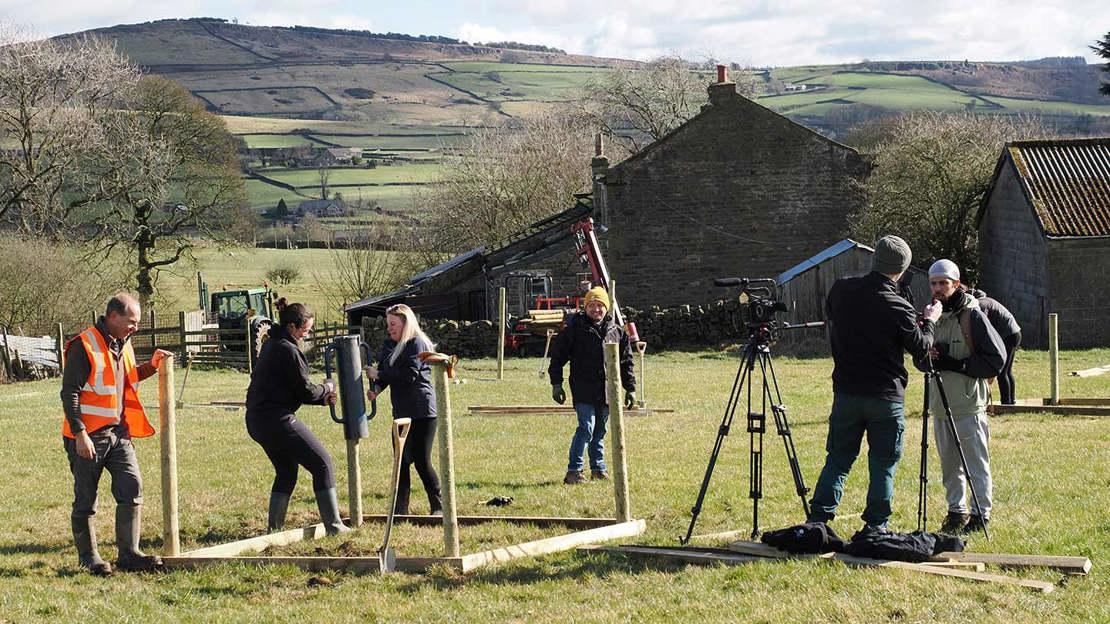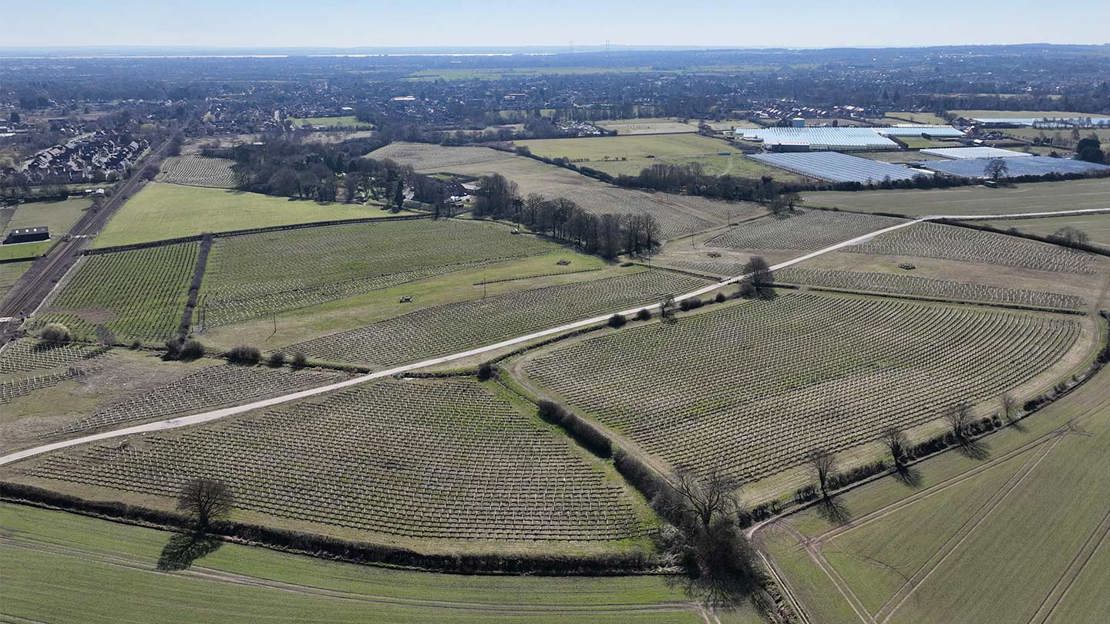More than 10 million trees planted across the Northern Forest

Senior PR officer
More than 10 million trees have now been established across the North of England as part of the Northern Forest scheme, which launched in 2018.
The Northern Forest, a partnership between the Woodland Trust, The Mersey Forest, Manchester City of Trees, the White Rose Forest, Humber Forest and the Community Forest Trust, has now established enough new trees to cover an area the size of 2,800 football pitches through tree planting and creating conditions for trees to reproduce on their own.
The new trees and woodlands have been established in towns, cities and rural locations across an area that stretches from the Mersey to the Humber, including in and around Liverpool, Chester, Preston, Manchester, Bradford, Leeds, Sheffield, York, Hull and Beverley.
During the 2024/25 planting season, over 2.2 million new trees were planted across the Northern Forest, the highest annual tree planting recorded since its launch. This includes over 4,100 standard trees in towns and cities, and new hedgerows on farms to benefit wildlife and the resilience of farming businesses.
Thousands of volunteers have been involved in the planting, from local community, school, faith and environmental groups to local businesses, contractors and corporate partners. The Northern Forest programme is working with landowners, local communities and businesses across the region to establish at least 50 million trees across the region.

Trees are vital for clean air, health and wellbeing, as well as driving nature recovery, climate resilience, slowing water flow to reduce flooding and encouraging green growth. Research by the Woodland Trust in 2024 revealed that 9 in 10 people felt that woodland biodiversity has a positive impact on their wellbeing, while UK forests annually remove approximately 18.3 million tonnes of carbon dioxide from the atmosphere – almost 5% of the UK’s emissions.
Evidence gathered across the Northern Forest showed that between 2018 and 2023 the new woodlands created through the programme:
- provided a £43 million economic uplift for the North of England each year
- locked up an additional 19,000 tonnes of carbon every year, helping to reduce climate change
- resulted in an additional 300,000 households living less than a 10-minute walk away from a publicly accessible woodland, including 87,500 in the most deprived communities in England, delivering health and wellbeing benefits
- created an additional 423,000 cubic metres of water storage, reducing flooding risk to local communities.
The Northern Forest also promotes tree equity, which means it is reducing the disparity between people’s access to trees and woodlands in different parts of the country. When the Northern Forest project began in 2018, the region had just 7.6% tree cover in comparison to a national average of 13%.
Nick Sellwood, Northern Forest programme director for the Woodland Trust, said:
“It is incredible that the Northern Forest has passed the milestone of 10 million trees planted in towns, cities and rural areas across the region. It shows the importance of the investment being made by central government and the strong support given to the Northern Forest by decision makers in the region. The core Northern Forest partners are also working to gain additional support from corporate partners and make green finance a bigger component as we look to the next phase of delivery.
“Delivering woodland at this scale involves working with a whole range of partners, funders, community groups, businesses, contractors, thousands of volunteers and an incredible amount of sweat and graft. But it is so rewarding to think of all the families and communities who now live just a short walk from a woodland as a result. They will be able to enjoy all the benefits of trees, from cleaner air to improved mental health, and from flooding reduction to the sound of birdsong.
“It’s also transformative for nature in the region. One oak tree can have 1,000 different species associated with it. Just imagine the number of species of fungi, lichens, insects, birds and other wildlife that will thrive because of these 10 million trees being planted – it’s quite breathtaking. It’s also transforming the region economically. The Northern Forest has provided a £43 million economic uplift for the North of England each year.
“Work doesn’t stop here though. We will keep striving towards our goal of at least 50 million new trees, transforming the landscape across the Northern Forest, helping us become more resilient to the changing climate and providing benefits for people, nature and the economy.”

Paul Nolan, director of The Mersey Forest and chair of England’s Community Forests, said:
“Community forestry exists where the need is the greatest. By increasing tree cover and enabling nature recovery across the North of England, we’re helping to create places that are healthier to live, work and do business. Places where people are more connected with nature and, in turn, where they care for the greenspaces around them. Our woodlands and greenspaces are essential to help us adapt to changing climates, to help us live happy, healthy lives and provide neighbourhoods that we’re proud to call our home.
“Planting 10 million trees is a fantastic achievement to date and, as a partnership, we are looking forward to continuing to work with our partners, local landowners and communities to deliver the next 10 million.”
The Northern Forest is supported by Defra’s Nature for Climate Fund, including support for the Northern Forest Grow Back Greener programme, led by the Woodland Trust, and the Trees for Climate programme, led by England’s Community Forests.
Nature Minister Mary Creagh said:
"With this government, tree planting rates are now at the highest level in over 20 years. We rapidly established a new Tree Planting Taskforce, announced the first of three new national forests and these figures show we are making good progress.
"There is much more to do – that is why we are investing over £800 million to plant trees across the country as part of our Plan for Change."

Case studies from Northern Forest projects
Greater Manchester Fire Stations (City of Trees)
City of Trees, the Community Forest for Greater Manchester, worked with Greater Manchester Fire and Rescue Service to plant trees at multiple fire stations across Greater Manchester. The trees were provided by the Northern Forest programme.
Forty standard trees – trees with a single upright trunk of at least six feet – were planted at eight fire stations, mostly during National Tree Week in November 2024.
The trees were planted by the City of Trees in-house contract team. People in this team have been recruited as part of the City of Trees’ green jobs programme which provides work and training for people from the Greater Manchester area coming into the sector from non-traditional routes. Some firefighters also joined in with the planting.
Staff at the fire stations welcomed the new trees as ways to boost health and wellbeing, especially due to the high pressure nature of their roles, as well as highlighting the benefit the trees will bring to the local community.
Watch a short film about the case study.
Oak Road Playing Fields, Hull (Humber Forest)
Oak Road is an urban area of Hull alongside the river, which is prone to flooding.
With funding through the Northern Forest Grow Back Greener programme, 25 large standard trees and 684 unbranched young tree seedlings (whips) were planted by local residents who took part in a community planting day.
As parts of the site are prone to flooding, suitable wet woodland species such as willow and alder were planted to help alleviate this. The planting will create areas of shade in the summer for those using the playing fields, as well as provide habitats for a wide range of species.
Watch a short film about the case study.
Delivering trees and woodlands in Liverpool (The Mersey Forest)
The Mersey Forest has been working alongside Liverpool City Council to help increase woodland and tree cover across the city, as part of the council’s Climate Emergency targets. Since 2018, over 10 hectares of trees have been planted across more than 20 greenspaces, funded through the Northern Forest Grow Back Greener programme.
The Mersey Forest team selected locations to introduce more trees so that they would compliment existing park activity and, in some cases, address issues such as wet ground in parks and designing landscapes that would draw more footfall to some less visited areas.
Local community groups such as Friends of Princes Park, Friends of Norris Green Park and Friends of Sefton Park provided support for the project and help with some ongoing maintenance.
In one city park, more than 20 tree species were planted by a community group to create a mixed-height canopy for the new woodland, including fruiting, nut-bearing and flowering species such as guelder rose, spindle, holly, hazel, and wild cherry. The local friends group now carry out regular hand weeding and mulching of trees. Native wildflower mixes have also been incorporated into some of the woodland planting to increase biodiversity in the area.
The funding from the Grow Back Greener programme also paid for over 1,000 standard trees, to compliment the sapling planting and help connect the new trees to different areas of woodland and other initiatives in parks, such as park runs, tree trails and green gyms. Using funding from a range of grants, Liverpool City Council have linked green corridors, bringing trees into more urban settings, where possible, helping to capture particles from traffic pollution. This funding has also provided the opportunity to introduced more edible tree varieties, plus explore introducing different tree species that will be more resilient in our changing climate, alongside a mix of native trees.
March Haigh, South Pennines (The White Rose Forest)
The White Rose Forest and the National Trust developed plans for an ambitious woodland creation scheme at March Haigh.
Located within the northern part of the Marsden Moor Estate, March Haigh is a protected area of peat moorland and upland cloughs owned and managed by the National Trust. Opportunity mapping identified the area as a key location for woodland creation for natural flood management, habitat creation and connectivity, climate mitigation and helping to prevent moorland fires.
The White Rose Forest supported the project through their Trees for Climate programme, funded by Defra. The project also contributes to the wider landscape-scale nature restoration programme led by the National Trust and Yorkshire Water in West Yorkshire.
Following rigorous planning and consultation, 65,000 trees were planted to create 63 hectares of native woodland at March Haigh between 2023 and 2024. The trees planted included a mix of native broadleaf trees and shrubs common to existing clough woodlands in the South Pennines.
The design was carefully adapted to create a well-designed woodland that is sympathetic to the landscape, with species selections and planting densities bespoke to the site. Surveys, including peat depth, breeding birds, habitat, grassland fungi, geophysical and landscape assessment made sure any planting would not affect the site’s visual and environmental integrity.
Watch a short film about the case study.
Hayhills Farm Wood, West Yorkshire (the Woodland Trust)
It has been a century or more since the land at Hayhills Farm Wood, close to Silsden in Yorkshire, was teeming with life.
Once home to biodiverse, ancient woodland but now 98 acres of mostly open and nature-poor land, the site was purchased by the Woodland Trust in partnership with Lloyds Banking Group to be restored into a thriving, high canopy woodland for the future, featuring oak, birch and hazel trees.
The aim is to connect, through hedgerows and trees on farmland, the Hayhills Farm Wood to four other woodland habitats in the area, thereby creating a wider biodiverse landscape for wildlife and nature to flourish.
Throughout March 2025, tree planting was at full pace, involving local school groups, community and faith groups, Climate Action Silsden, community tree planting group YourGreen CIC and corporate volunteers from Lloyds Banking Group, Pets at Home, Aviva and Premier Paper.
More than 38,000 trees were planted on the site and every single one was planted by one of the 1,600 volunteers.
The tree planting at Hayhills Farm Wood is being funded through the Northern Forest Grow Back Greener programme, which is led by the Woodland Trust in partnership with White Rose Forest, with funding from DEFRA.
Watch a short film about the creation of Hayhills Farm Wood.
Notes to editors
For more information, please contact the Woodland Trust PR team at media@woodlandtrust.org.uk or on 033 033 35313.
About the Woodland Trust
The Woodland Trust is the largest woodland conservation charity in the UK with more than 500,000 supporters. With a vision of a world where woods and trees thrive for people and nature, today the Trust owns and cares for more than 1,000 woodland sites, covering around 33,000 hectares.
The Woodland Trust has three key aims:
- protecting the UK's rare, unique and irreplaceable ancient woodland
- restoring damaged ancient woodland, nurturing precious pieces of our natural heritage back to life
- establishing new native trees and woods to create healthy, resilient landscapes for people and wildlife.
Access to all Woodland Trust woods is free so everyone can experience the physical and mental benefits of trees.
About the Northern Forest
A partnership between The Woodland Trust, the largest woodland conservation charity in the UK, the Community Forests including City of Trees (Greater Manchester), The Mersey Forest, Humber Forest and White Rose Forest, and the Community Forest Trust, is delivering this ambitious project.
The partnership is connecting people with nature by creating growth and investment opportunities, reducing climate change and flood risk, improving health and wellbeing, supporting the rural economy and developing innovative funding mechanisms for the future. The Northern Forest is supported through Defra and other funders.
GDPR
The Woodland Trust uses Cision to obtain work contact details for journalists and editors that we feel may be interested in a particular press release or story. If you do not wish to be contacted in the future by the Woodland Trust, please email media@woodlandtrust.org.uk and let us know you wish to be taken off any or all lists.

